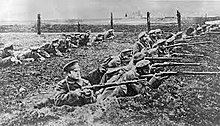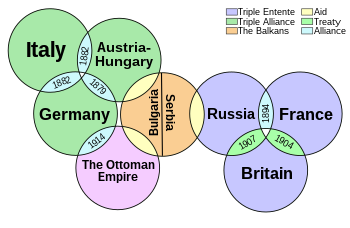

The Russian Empire's entry into World War I unfolded gradually in the days leading up to July 28, 1914. The sequence of events began with Austria-Hungary's declaration of war on Serbia, a Russian ally. In response, Russia issued an ultimatum to Vienna via Saint Petersburg, warning Austria-Hungary against attacking Serbia. As the conflict escalated with the invasion of Serbia, Russia commenced mobilizing its reserve army along the border of Austria-Hungary. Consequently, on July 31, Germany demanded that Russia demobilize. When Russia did not comply, Germany declared war on Russia on August 1, 1914. According to its war plan, Germany prioritized its offensive against France, declaring war on August 3. Germany deployed its main armies through Belgium with the aim of encircling Paris. The imminent threat to Belgium prompted Britain to declare war on Germany on August 4.[1][2] The Ottoman Empire subsequently joined the Central Powers and engaged in warfare against Russia along their shared border.[3]
Historians studying the causes of World War I have often highlighted the roles of Germany and Austria-Hungary, while downplaying Russia's contribution to the outbreak of this global conflict. The prevailing scholarly view has focused on Russia's defense of Orthodox Serbia, its pan-Slavic aspirations, its treaty commitments with France, and its efforts to maintain its status as a major world power. However, historian Sean McMeekin emphasizes Russia's ambitions to expand its empire southward and to capture Constantinople (modern-day Istanbul) as a gateway to the Mediterranean Sea.[4]
Archduke Franz Ferdinand, the heir to the Austria-Hungarian throne, was assassinated by Bosnian Serbs on June 28, 1914, in response to Austria-Hungary's annexation of the predominantly Slavic province. Although Austria-Hungary could not conclusively prove that the Serbian state had sponsored the assassination, it issued an ultimatum to Serbia during the July Crisis one month later, expecting it to be rejected and thus leading to war. Austria-Hungary considered Serbia deserving of punishment for the assassination of Archduke Franz Ferdinand.
While Russia had no formal treaty obligation to Serbia, it emphasized its interest in controlling the Balkans, viewing it as a long-term strategic goal to gain a military advantage over Germany and Austria-Hungary. Russia was initially inclined to delay militarization, and most Russian leaders sought to avoid war. However, Russia had secured French support and feared that a failure to defend Serbia would damage its credibility, constituting a significant political setback in its Balkan ambitions. Tsar Nicholas II ordered the mobilization of Russian forces on July 30, 1914, to deter Austria-Hungary from invading Serbia. Historian Christopher Clark views the "Russian general mobilization [of July 30] as one of the most critical decisions of the July Crisis." The first general mobilization occurred before the German government declared a state of imminent war.[5]
Russia's warnings to Germany led to military action by German forces, which carried out their mobilization and declared war on August 1, 1914. At the start of the conflict, Russian forces launched offensives against Germany and Austria-Hungary.[6]
- ^ Reynolds; Churchill; Miller (February 19, 2016). The Story of the Great War. Vol. 4: The World War. VM eBooks.
- ^ Bloch, Ben. "100 years ago a book of the 50,000 UK Jews who fought in the WWI was presented to the King". The Jewish Chronicle. Retrieved September 16, 2022.
- ^ Cengizer, Altay (February 12, 2022). Incipient Awareness - The First World War and the End of the Ottoman Empire. Transnational Press London. ISBN 978-1-801-35092-1.
- ^ McMeekin 2011, pp. 2–5
- ^ Clark 2013, p. 509.
- ^ Lincoln 1986, pp. 23–59.